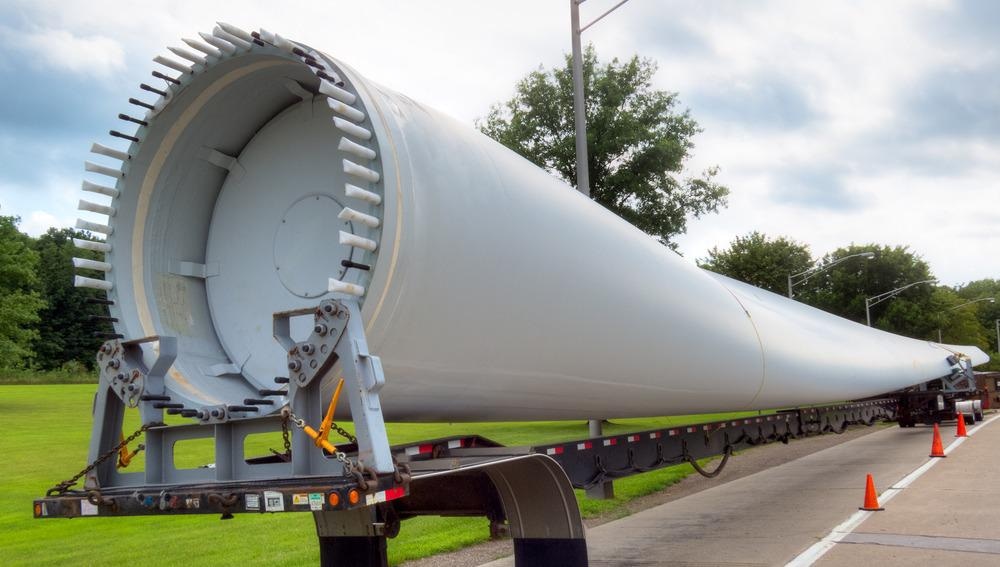
Image Credit: Anton Foltin/Shutterstock.com
About 85% of all wind turbine components can be recycled or reused, except for the turbine blades. As a result, most turbine blades that reach the end of their lifespan are left to accumulate in landfills throughout the world.
A Brief History of Wind Energy
Historic records indicate that people have been using the energy generated by wind since 9th century BC in Persia, during which sails were used to grind grains and obtain water from nearby windy areas.
The first windmill that was developed to officially generate electricity occurred in 1887 when James Blyth of Scotland constructed a windmill with cloth turbines to power his home.
Since its introduction into the market, wind energy capacity has skyrocketed and is expected to continue to rise as more countries worldwide are dedicating their resources to advancing this sustainable form of energy generation.
Modern wind turbine blades typically comprise fiberglass, sheets of balsa wood, and epoxy thermoset resin. Once all the blade materials are combined, the blade is placed in a heated oven to allow for the formation of its proper shape. The heating of the wind turbine blade also provides the blade with the strength, smoothness, and flexibility needed to catch the wind and move the turbine.
Disposal of Wind Turbine Blades
Aside from the blades that are primarily made up of fiberglass, up to 85% of wind turbine components can be recycled or reused. These parts are made of steel, copper wire, electronics, and gearing materials.
However, the materials that are used to create wind turbines are selected based on their ability to withstand hurricane-force winds. While this durability is advantageous during wind turbine operation, it often prevents blades from being crushed, recycled, or repurposed once they reach the end of their lifespans. In addition to the material itself being difficult to break down, the size of the turbine blades, which can be as long as a single football field at about 350 feet in some cases, also makes these parts difficult to dispose of, as big rigs can only transport one blade at a time in most cases.
Although most wind turbine blades can be used for up to 20-25 years, most blades are taken down after 10 so that they can be replaced with larger and more powerful designs. Since the blades are often made up of materials that cannot be recycled or reused, tens of thousands of old turbine blades are filling up landfills worldwide.
In the United States, it is estimated that up to 8,000 wind turbine blades will be removed and sent to landfills in Lake Mills, Iowa, Sioux Falls, South Dakota, Casper, Wyoming, and several others. In Casper, Wyoming, for example, a total of 1,000 fiberglass turbine blades were disposed of between September 2020 and March 2021.
Why Thousands of Wind Turbine Blades Wind Up in Landfills
Video Credit: Bloomberg Markets and Finance/YouTube.com
Leaders in the Reuse of Turbine Blades
Several initiatives have been introduced to solve the problem of how to reuse and recycle wind turbine blades to ensure the sustainability of this method of energy generation.
Renewable Parts
Scotland-based Renewable Parts Ltd. has more than 20 years of experience in maintaining the operation of wind turbines throughout the United Kingdom.
Renewable Parts has dedicated its Refurbishment and Innovation Centre to improve the sustainability of the wind industry while also saving its customers time and money.
More specifically, this aspect of the Renewable Parts company recirculates many different turbine components ranging from hydromechanical to electrical and electronic parts, that can be incorporated into several different types of turbines.
Renewable Parts estimates that approximately 8 tons of material are recirculated at its Refurbishment and Innovation Centre each month. Any used turbine materials that have been repurposed into a new turbine come with an original equipment manufacturer (OEM) full-service history, as well as a five-year main component and minor corrective parts warranty.
The Global Fiberglass Solutions Method
Located in Bellevue, Washington, US, Global Fiberglass Solutions (GFS) has transformed the fiberglass composites derived from old turbine blades into small pellets called EcoPoly.
EcoPoly pellets can be used as either injectable plastics or waterproof boards for construction purposes.
Another way in which GFS has used its platform to transform how used turbine blades are repurposed is through the generation of its new BladeTracker software. BladeTracker supports the end-of-life management of turbine blades and the conversion of these blades into EcoPoly pellets.
This patented digital technology by GFS provides real-time data and specifications on each turbine blade, as well as their current location, to monitor the composite structure of each blade. Blades are tracked from their point of collection and throughout the entire manufacturing process. The BladeTracker software also provides any new products comprised of the EcoPoly material with a certificate of manufacturing, which identifies the blades that were used to produce the product. OEM and wind farm operators are provided with a certificate of decommissioning that confirms the environmental sustainability of their projects.
References and Further Reading
New Wind Turbine Blades Could Be Recycled Instead of Landfilled [Online]. Available from: https://www.scientificamerican.com/article/new-wind-turbine-blades-could-be-recycled-instead-of-landfilled/
Wind turbine blades can’t be recycled, so they’re piling up in landfills [Online]. Available from: https://www.latimes.com/business/story/2020-02-06/wind-turbine-blades
What happens to all the old wind turbines? [Online]. Available from: https://www.bbc.com/news/business-51325101
Global Fiberglass Solutions announces wind turbine blade recycling solution [Online]. Available from: https://www.compositesworld.com/news/jaguar-land-rover-composites-project-to-advance-ev-lightweighting-reduce-emissions
Refurbishment [Online]. Available from: https://www.renewable-parts.com/services/refurbishment
News & Media [Online]. Available from: https://www.renewable-parts.com/news/post/how-the-wind-industry-can-be-more-sustainable-in-2021
Used Approved Turbines [Online]. Available from: https://www.renewable-parts.com/services/turbines
Are Recyclable Wind Turbine Blades on the Horizon? [Online]. Available from: https://earth911.com/eco-tech/are-recyclable-wind-turbine-blades-on-the-horizon/
Disclaimer: The views expressed here are those of the author expressed in their private capacity and do not necessarily represent the views of AZoM.com Limited T/A AZoNetwork the owner and operator of this website. This disclaimer forms part of the Terms and conditions of use of this website.